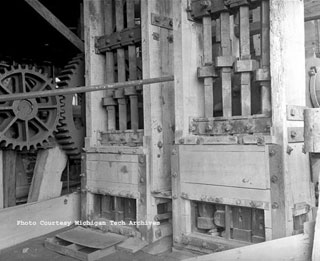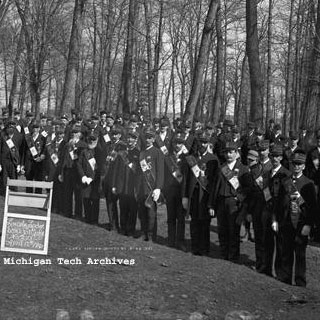An Interior Ellis Island (Print Version)
Keweenaw Ethnic Groups
The Cornish
Close
Abstract
Cornish “Cousin Jacks” provided Michigan’s
developing copper district with much of its early mining expertise. Highly
skilled from established tin and copper mining operations in Southwestern
England, the Cornish were synonymous around the world with mining. “Wherever
there is a hole in the earth, you will find a Cornishman at the bottom,” went
a popular slogan (Cornish
1). Fiercely independent, Cornish miners negotiated independent
contracts with mining companies for their work and brought along important
mining techniques, technologies, and terminology to the Keweenaw. Socially,
the Cornish were apolitical and reverent Methodists, though their enjoyment
of music, wrestling, and foods such as the pasty provide colorful reminders
of their place in Keweenaw history.
| Old Cliff Cornish Stamp Image #: MS042-006-053-569 |
Cornwall is located on a peninsula of land at the very southwestern tip of England. Deposits of tin and copper were the subject of modern mining development as early as the 16th century. From 1800 to 1830, Cornwall produced two-thirds of the world’s copper, with the peak of production in 1856. The Cornish peninsula offered economic opportunities for both mining and small-scale farming; it wasn’t unusual for a Cornish miner to balance his income between work underground and in the fields. Following its zenith in the early 19th century, the Cornish mining economy fell into decline and, combined with a scarcity of available farming land, pushed many residents toward emigration. For many skilled Cornish miners, the route often led to developing mining areas in North America (Cornish 2).
An initial migration in the 1830s and 1840s brought some to iron mines in the Eastern United States, while others located in the lead mining district near Mineral Point, Wisconsin. From there, some began to make their way north to the fledgling Lake Superior copper district. By the mid 1860s, a severe slump in Cornish copper mining created a lasting depression and larger numbers of miners immigrated directly to the Keweenaw Peninsula (Cornish 3).
Cornishmen were often ascribed the nickname “Cousin Jacks” – supposedly in reference to their quick ability to recommend a member of the extended family to fill a job vacancy (Cornish 4). These cousins, uncles, brothers and fathers brought additional underground mining expertise into the Michigan copper district, along with established mining practices and technologies from their home country.
At a basic level, much of the mining terminology used in Michigan copper mines can be traced to Cornwall. Words such as “kibble” and “skip” (the buckets used to hoist rock to the surface) and “lode” and “stope” (referring to an ore body and the mining technique used to remove it) are examples that persist in modern-day mining (Cornish 5). Cornish miners also imported a medical aid system in which each man contributed to an aid fund, helping the company to employ doctors and maintain dispensaries at mine locations (Cornish 6).
The deep, wet mines of Cornwall had encouraged the invention and adaptation of technology to early underground mining. “By 1850,” noted historian A.L. Rowse, “Cornishmen had more expertise of deep mining and deep pumping.” Foundries in Southwestern England supplied the world with Cornish beam engines for pumping and hoisting, Cornish drop stamps for processing mine rock, as well as Cornish engineers and miners to operate these new technological tools (Cornish 7).
Importing a centuries-old Cornish system of contract mining, teams of Michigan copper miners negotiated independent contracts with mining companies which paid on the amount of copper they produced. The system provided men with a percentage of the mine’s revenue, raised Cornish miners beyond the level of mere wage earners, and provided them with a higher status in mining communities. “The Cornish became the immigrant elite,” notes historian Larry Lankton, “seldom relegated to unskilled work, but often tapped as skilled laborers, bosses, captains or agents (Cornish 8).”
| Lincoln Lodge Sons of St. George Image #: MS042-039-T-006 |
Yet Cornish immigrants also imported other less divisive cultural traditions. Cornish immigrants organized chapters of the Sons of St. George fraternal society in Central Mine, Mohawk, Calumet, Lake Linden, Houghton, and South Range. Annual St. George’s Day festivities, convened on April 23, offered opportunities for parades and concerts. Summer picnics featured cricket and Cornish wrestling matches, rock drilling contests and traditional foods such as saffron cakes. The Cornish introduced the pasty – a pastry turnover filled with meat and vegetables – to the Upper Peninsula. Other ethnic groups adopted and adapted the pasty to their own tastes, sparking much subsequent controversy over the specific ingredients of so-called “authentic” recipes (Cornish 11).
Social status and a common language allowed Cornish immigrants to move more freely amongst the social classes in the American-lead mining community. Although first-generation immigrants were likely to marry other Cornish-born, sharing a common language accelerated intermarriage outside the ethnic group. Experience-bred Cornish mining captains such as William Harris, James Pryor, Richard Uren, William Parnall and brothers John and Richard Hoar rose to positions of social prominence in local mining, mercantile and transportation industries, while their sons comprised many of the early graduating classes of the Michigan Mining School, now Michigan Technological University.
Although some current Copper Country residents trace roots back through Cornish mining families, many Cornish miners moved out from the region as copper values began to decline. Increased mechanization of the Michigan mines favored unskilled immigrants from non-mining backgrounds. Although some purchased local farm holdings, the soil and climate of northern Michigan were not conducive to farming. Some continued with new mines in developing districts of Montana, Arizona, South America and Africa. Others left mining altogether – many driven away by the labor and social unrest of the 1913 strike – and made their way into manufacturing industries in Chicago, Milwaukee, and Detroit. “The day of the Cornish as miners is over,” noted Copper Range Company president William Paine in the early 1920s, “Ford is keen on Cornishmen and most of them go to Ford.” By 1930, fewer than 1,500 persons of English birth remained in the Copper Country (Cornish 12).
Further Reading:
Roger Burt, ed., Cornish Mining: Essays on the Organisation of Cornish Mines and the Cornish Mining Economy, New York: Augustus Kelley, 1969.
James Fisher, “Michigan’s Cornish People,” Michigan History, Vol. XXIX, March 1945, 377-385.
James E. Jopling, “Cornish Miners of the Upper Peninsula,” Michigan History, Vol. XII, May 1928, 554-567.
Terry S. Reynolds, “The Persistence of Cornish Influence in Regional Methodism: The Case of Grace Methodist of Houghton, 1854-1920,” in New Perspectives on Michigan’s Copper Country, Hancock: Quincy Mine Hoist Association, 2007.
John Rowe, The Hard Rock Men: Cornish Immigrants and the North American Mining Frontier, New York: Barnes & Noble Books, 1974
John Rowe, “Cornish,” in Harvard Encyclopedia of American Ethnic Groups (Stephan Thernstrom, editor), Cambridge, Mass.: Belknap Press, 1980.
A.L. Rowse, The Cousin Jacks: The Cornish in America, New York: Scribner, 1969.
Arthur Cecil Todd, The Cornish Miner in America, Truro: Bradford Barton, 1967.
(Cornish 1)
A.L.
Rowse reprinted in Arthur Thurner, Calumet, Copper and People: history
of a Michigan mining community, 1864-1970 (Chicago: The Author, 1974),
p14.
Close
(Cornish 2)
It
is important to note that the history of “Cornish mining” generally
includes mineral extraction and processing in the English counties of
both Cornwall and Devon. Although often overshadowed by notoriety of
its neighboring county, Devon has historically accounted for a larger
percentage of the metals produced from Southwestern England. Literature
concerning Cornish immigrants to Michigan often intermingles people from
both counties, though closer examination confirms several “Cornish
mining captains” who were born and raised in Devonshire. For a
concise overview of Cornish mining and its decline, see John Rowe, “Cornish,” in
Harvard Encyclopedia of American Ethnic Groups (Cambridge, Mass.” Belknap
Press, 1980), p244, and A.L. Rowse, The Cousin Jacks: The Cornish in
America, (New York: Scribner, 1969), p161-166.
Close
(Cornish
3)
John Rowe, “Cornish,” p244.
Close
(Cornish
4)
Arthur Thurner references this common nickname in (Calumet Copper & People,
p27) as does John Rowe (“Cornish,” p244), though Rowe concedes
that the phrase “may have far more ancient origins.”
Close
(Cornish
5)
Both Arthur Thurner and James E. Jopling examine the use of Cornish
terminology in Michigan’s copper district, though Jopling also
acknowledges that the Cornish language evolved from many other Celtic
and European sources. See Arthur Thurner, Strangers and Sojourners: A
History of Michigan’s Keweenaw Peninsula (Detroit: Wayne State
University Press, 1994), p. 332, note 27, and James E. Jopling, “Cornish
Miners of the Upper Peninsula,” Michigan History, Vol. XII, May
1928, p559-60.
Close
(Cornish
6)
Arthur Thurner, Calumet Copper and People, p14, and Larry Lankton,
Beyond the Boundaries: Life and landscape at the Lake Superior copper
mines, 1840-1875 (New York: Oxford University Press, 1997), p151.
Close
(Cornish 7)
A.L. Rowse, The Cousin Jacks: The Cornish in America (New York: Scribner,
1969), p162.
Close
(Cornish 8)
Larry
Lankton, Cradle to Grave: Life, work, and death in the Lake Superior
copper mines (New York: Oxford University Press, 1991), p61-63. The status
of Cornish in area mines is also discussed in John Rowe, “Cornish,” p244,
and A.L. Rowse, The Cousin Jacks, 168.
Close
(Cornish
9)
Terry S. Reynolds, “The Persistence of Cornish Influence in Regional
Methodism: The Case of Grace Methodist of Houghton, 1854-1920,” in
New Perspectives on Michigan’s Copper Country, Hancock: Quincy
Mine Hoist Association, 2007.
Close
(Cornish
10)
John Rowe (“Cornish,” p245) and Larry Lankton (Cradle to
Grave, p229) examine Cornish in the Civil War and the 1913 strike. Clashes
between the Cornish and Irish are routinely mentioned in the literature,
including A.L. Rowse (The Cousin Jacks, p170) and Arthur Thurner (Calumet
Copper and People, p27).
Close
(Cornish
11)
Arthur Thurner includes a detailed report on the 1898 St. George’s
Day celebrations in Calumet (Calumet Copper and People, p30-31). For
information on the Sons of St. George, see Arthur Thurner, Strangers
and Sojourners, p135, and John Rowe (“Cornish,” p245).
Close
(Cornish
12)
John Rowe references Cornish attempts at farming (“Cornish,” p244)
as does A.L. Rowse (The Cousin Jacks, p179). Paine quote is carried in
Larry Lankton, Cradle to Grave, p246. A useful tool for examining ethnicity
is the historical census browser maintained by the University of Virginia
library at http://fisher.lib.virginia.edu/collections/stats/histcensus
Close

